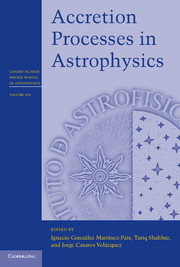Book contents
- Frontmatter
- Contents
- List of contributors
- List of participants
- Preface
- Acknowledgments
- Abbreviaions
- 1 Accretion disks
- 2 The evolution of binary systems
- 3 Accretion onto white dwarfs
- 4 Multiwavelength observations of accretion in low-mass X-ray binary systems
- 5 X-ray binary populations in galaxies
- 6 Observational characteristics of accretion onto black holes I
- 7 Observational characteristics of accretion onto black holes II: environment and feedback
- 8 Computing black-hole accretion
- A Piazzi Smyth, the Cape of Good Hope, Tenerife, and the siting of large telescopes
- References
6 - Observational characteristics of accretion onto black holes I
Published online by Cambridge University Press: 05 January 2014
- Frontmatter
- Contents
- List of contributors
- List of participants
- Preface
- Acknowledgments
- Abbreviaions
- 1 Accretion disks
- 2 The evolution of binary systems
- 3 Accretion onto white dwarfs
- 4 Multiwavelength observations of accretion in low-mass X-ray binary systems
- 5 X-ray binary populations in galaxies
- 6 Observational characteristics of accretion onto black holes I
- 7 Observational characteristics of accretion onto black holes II: environment and feedback
- 8 Computing black-hole accretion
- A Piazzi Smyth, the Cape of Good Hope, Tenerife, and the siting of large telescopes
- References
Summary
Abstract
These notes resulted from a series of lectures at the IAC winter school. They are designed to help students, especially those just starting in subject, to get hold of the fundamental tools used to study accretion powered sources. As such, the references give a place to start reading, rather than representing a complete survey of work done in the field.
I outline Compton scattering and blackbody radiation as the two predominant radiation mechanisms for accreting black holes, producing the hard X-ray tail and disk spectral components, respectively. The interaction of this radiation with matter can result in photoelectric absorption and/or reflection. While the basic processes can be found in any textbook, here I focus on how these can be used as a toolkit to interpret the spectra and variability of black-hole binaries (hereafter BHB) and active galactic nuclei (AGN). I also discuss how to use these to physically interpret real data using the publicly available XSPEC spectral fitting package (Arnaud, 1996), and how this has led to current models (and controversies) of the accretion flow in both BHB and AGN.
6.1 Fundamentals of accretion flows: observation and theory
6.1.1 Plotting spectra
Spectra can often be (roughly) represented as a power law. This can be written as a differential photon number density (photons per second per square cm per energy band) as N (E) = N 0E-r, where Γ is photon index. The energy flux is then simply F (E) = EN(E) = N0E-(r-1) = N0E-α, where α = Γ − 1 is energy index.
- Type
- Chapter
- Information
- Accretion Processes in Astrophysics , pp. 184 - 226Publisher: Cambridge University PressPrint publication year: 2014
References
- 2
- Cited by

